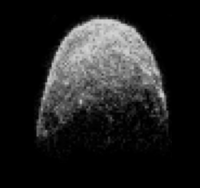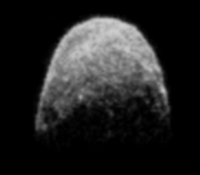Printable Version of Topic
Click here to view this topic in its original format
Unmanned Spaceflight.com _ Cometary and Asteroid Missions _ Earth to Perform Asteroid 'Flyby'
Posted by: Toma B May 3 2011, 09:02 AM
http://www.jpl.nasa.gov/news/news.cfm?release=2011-129
In the text above it clearly says: "The best resolution of the radar images was 7.5 meters [25 feet] per pixel , when the asteroid was about 2.3 million kilometers away from Earth back in April 2010." Than it says that "When 2005 YU55 returns this fall the asteroid will be seven times closer. We're expecting some very detailed radar images. "When 2005 YU55 returns this fall, we intend to image it at 4-meter resolution with our recently upgraded equipment at the Deep Space Network at Goldstone, California." [/quote]
So where is that upgrade?!? ![]()
When imaging from 2,300,000 Km res= 7.5 m/pix
When imaging from 325,000 Km res= 4 m/pix
I just don't get it. If there was no "upgrade" resolution should be about 1 m/pix this time because asteroid is 7 times closer!
Can anybody understand/explain this?
Posted by: tedstryk May 3 2011, 09:42 AM
So where is that upgrade?!?
When imaging from 2,300,000 Km res= 7.5 m/pix
When imaging from 325,000 Km res= 4 m/pix
I just don't get it. If there was no "upgrade" resolution should be about 1 m/pix this time because asteroid is 7 times closer!
Can anybody understand/explain this?
The earlier flyby was imaged using the much larger antenna at Arecibo. This flyby will be imaged by the upgraded but much smaller antenna at Goldstone. Due to the asteroid's location in the sky at the time of the flyby, it will be inaccessible to Arecibo.
Posted by: Hungry4info May 3 2011, 10:37 AM
So essentially, Earth's camera pointing is not being used for the flyby. ![]()
Posted by: Phil Stooke May 3 2011, 02:32 PM
The resolution of delay-doppler imaging has nothing to do with distance, unlike optical imaging. It's a measure of how finely we can sample the returned signal in time and frequency. The effect of distance is to change the SNR, so a more distant target might have to make use of binned data, which is where the resolution will suffer, but it's not just a geometric issue like it would be for optical imaging.
Phil
Posted by: Holder of the Two Leashes May 3 2011, 02:52 PM
It's not quite so simple, as this is not a passive observation but an active probe. The increase in resolution you are talking about could roughly be achieved by interferometric techniques (which might be used with the VLA, for instance), but with monostatic and bistatic (two antennas, such as Aricebo transmits and Goldstone receives) observations you have limitations due to time delay (ranging) and radio frequency (doppler shift) resolutions. Plus some minor limitations due to wavelengths (3.5 cm for Goldstone, 12 for Aricebo).
Goldstone will typically image an asteroid with about 0.1 microsecond bursts of radio waves. This results in a radio "pancake" about 30 meters thick. That is the relatively blunt instrument they use to image an object only 400 meters big. How they manage to process the return signal that comes back in a way that resolves detail smaller than that is beyond me, but they do manage it.
What you mainly get with this close approach is about 49 (7 squared) times more of the transmitted power being intercepted by the asteroid, and the same 49 times of the reflected signal being returned (the area of 2005 YU55 looks that much bigger this time), for a whopping gain of around 49 X 49 = 2401 (let's just say 2000-2500) times more of the transmitted signal being returned by the same antenna at the same power level this time around. A huge gain in signal-to-noise ratio.
But again it's more complicated than that. 2005 YU55 will be so close this time that some sites, like Goldstone, won't be able to both transmit and receive due to the quick round trip time. At closest approach, they are only planning bistatic observations.
The link here provides a http://echo.jpl.nasa.gov/asteroids/2005YU55/2005YU55_planning.html of their plans at Goldstone.
I'm looking forward to this event for other reasons, hoping that through my telescope I can see this rock showing visible motion against the background stars, something I've only seen once before with 2002 NY40.
Posted by: Paolo May 3 2011, 05:26 PM
any chances a distant artificial satellite may pass some thousand kilometers from it? a check of possible cometary emissions using magnetospheric instruments would be interesting science...
Posted by: Holder of the Two Leashes May 3 2011, 05:46 PM
Sorry, no chance. Telescopic observations should detect any activity, if present. But it's unlikely that there will be anything to see.
Posted by: tasp May 3 2011, 07:01 PM
I appreciate the radio 'pancake' analogy, makes what they are trying to do more understandable. (and more amazing)
Is the transmitted frequency constant during the microsecond burst, or does it vary? (I am trying to figure out how the 30 meter thick burst can be resolved so finely) really astonishing use of technology in any regard.
Posted by: Holder of the Two Leashes May 9 2011, 03:15 PM
The transmitted frequency is kept steady. Held to painfully tight tolerances, too.
I might mention here that the asteroid will move into Arecibo's line of sight very shortly before (but not during) closest approach on November 8th. Joint (bistatic) observations are planned with Goldstone, followed by stand alone studies through the 19th.
HOWEVER.....
Here is a list of the results of all asteroids schedueled for radar at Aricebo from November last year up to today:
2010 Nov - 2002 VE68 - Cancelled due to transmitter problems. R2564.
2010 Dec - 2006 VB14 - Cancelled due to transmitter problems. R2564
2010 Dec - 2010 JL33 - Cancelled due to transmitter problems. R2595
2010 Dec - (207945) 1991 JW - Cancelled due to transmitter problems. R2595
2010 Dec - 2005 GC120 - Requested but not scheduled. R2564.
2010 Dec - (16) Psyche - Cancelled due to transmitter problems. R2563.
2010 Dec - (337) Devosa - Cancelled due to transmitter problems R2563.
2011 Jan - (554) Peraga - Cancelled due to transmitter problems. R2313
2011 Jan - (7) Iris - Cancelled due to transmitter problems. R2313
2011 Jan - 2000 BD19 - Requested.
2011 Jan - 1998 HE3 - Requested but not scheduled.
2011 Feb - (153201) 2000 WO107 - Requested but not scheduled.
2011 Feb - 2001 CQ36 - Cancelled due to equipment problems. R2591
2011 Feb - 2000 EF104 - Cancelled due to equipment problems. R2591
2011 Feb - 2003 YG118 - Cancelled due to equipment problems. R2591
2011 Mar - (516) Amherstia - Cancelled due to transmitter problems. R2603
2011 Mar - 1999 TK12 - Cancelled due to transmitter problems. R2591
2011 Mar - 2009 FY4 - Cancelled due to transmitter problems. R2591
2011 Mar - 2005 EY169 - Cancelled due to transmitter problems. R2591
2011 Mar - (23187) 2000 PN9 - Cancelled due to transmitter problems. R2591
2011 Mar - 2005 ES70 - Cancelled due to transmitter problems. R2591
2011 Mar - (3554) Amun - Cancelled due to transmitter problems. R2591
2011 Mar - (11885) Summanus - Requested but not scheduled. R2591
2011 Apr - (85953) 1999 FK21 - Requested but not scheduled. R2591
2011 Apr - 2008 EY5 - Cancelled due to transmitter problems. R2591
2011 Apr - 2004 XN50 - Cancelled due to transmitter problems. R2591
2011 Apr - 1997 US9 - Requested but not scheduled. R2591
2011 Apr - 2003 FF5 - Requested but not scheduled. R2591
2011 Apr - 2001 AD2 - Cancelled due to transmitter problems. R2591
2011 Apr - 2004 QT24 - Cancelled due to equipment problems. R2591
2011 Apr - 2008 FU6 - Requested but not scheduled. R2591
2011 May - (141484) 2002 DB4 - Requested but not scheduled. R2591
2011 May - (164121) 2003 YT1 - Cancelled due to equipment problems. R2591. BINARY
2011 May - 2007 TB23 - Cancelled due to equipment problems. R2591
2011 May - 2003 AL73 - Cancelled due to equipment problems. R2591
I'm a little bit concerned here.
Posted by: ElkGroveDan May 9 2011, 04:14 PM
Look, if they say Arecibo can't do this one either because she has to wash her hair, I think asteroid watchers should take the hint and quit asking.
Posted by: jasedm May 9 2011, 04:24 PM
Hmmm, if I was a betting man..
Posted by: Paolo May 9 2011, 05:33 PM
my spidey sense tells me they are having equipment/transmitter problems
Posted by: tedstryk May 10 2011, 01:53 AM
I wonder if anyone will get a good view with adaptive optics...the views of 2002 NY40 were spectacular http://arxiv.org/PS_cache/arxiv/pdf/0709/0709.0984v1.pdf
Posted by: Holder of the Two Leashes Oct 28 2011, 04:27 AM
As of late September, the Aricebo radar was finally back in business, and pinged several NEAs in October. Here's hoping for the best.
Posted by: ugordan Nov 7 2011, 11:30 PM
http://www.nasa.gov/mission_pages/asteroids/news/yu55-20111107.html of 2005 YU55 from Goldstone taken on Nov 7th, a day before closest approach.
Posted by: Hungry4info Nov 8 2011, 12:06 AM
This is going to be a newby question, but why are the asteroids in these radar images not fully lit (full phase)? If the radar antennas bounce radio waves off the asteroids, wouldn't the detector and the light source effectively be in the same place?
Secondly, I'm surprised Arecibo is to be used during closest approach. I thought that the asteroid was too near Earth for the telescope to be used, due to the time it took for it to switch from sending to receiving.
Posted by: john_s Nov 8 2011, 12:36 AM
The answer is that radar images don't show the appearance of the asteroid in the plane of the sky, like a conventional camera. They are "delay/Doppler" images which means that the vertical distance in the image is the distance from the radar antenna (with the closest point to the antenna at the top of the image), and the horizontal distance shows the Doppler shift, which tells you the distance of each point from the spin axis of the asteroid.
So essentially you're looking at the asteroid from a direction perpendicular to the radar direction, in a plane that contains the spin axis, and with the asteroid being transparent so you can see both the "top" and "bottom" hemispheres simultaneously, superposed on each other.
John
Posted by: Hungry4info Nov 8 2011, 01:14 AM
Interesting! Thanks! Much appreciated.
Posted by: Phil Stooke Nov 8 2011, 03:49 AM
John's right, of course, but the same radar data could be used to create plane-of-sky images. Typically we do this for spherical objects like Venus (the most frequently imaged example)... and what you get is an image with north-south ambiguity and a blurry equator. For irregular objects like asteroids we don't know the plane-of-sky shape without further work, and the process gets too messy to work well. But plot it in delay-doppler coordinates and you get images like these, with the northern and southern sides superimposed. They are perfectly superimposed if the object is symmetrical, but in cases where the object is not symmetrical in delay-doppler space - like an elongated object tilted with respect to the incoming radar - most of the image is made only from one face of the object and there is only limited ambiguity around the sub-radar point.
Phil
Posted by: Astro0 Nov 9 2011, 12:46 AM
Here's a tweaked six frame animation of the asteroid rotation, a little larger and slower than the http://www.nasa.gov/mission_pages/asteroids/news/yu55-20111108.html.
Click to animate.
Posted by: dilo Nov 10 2011, 04:05 PM
This is my attempt to improve animation through de-pixalization (Gauss filter) and height reduction (better aspect ratio)
Thanks to Astro0 for source animation!
Posted by: Paolo Nov 16 2011, 07:10 PM
two interesting releases on YU55:
http://www.naic.edu/~pradar/asteroids/2005YU55/ and http://www.mpe.mpg.de/News/20111116/text.html
Powered by Invision Power Board (http://www.invisionboard.com)
© Invision Power Services (http://www.invisionpower.com)


